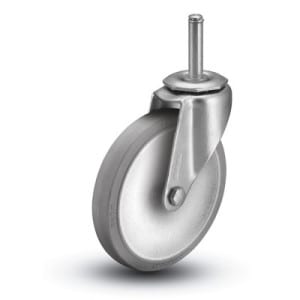 It’s dependent on the industry in which you are involved, but the majority of the time using ergonomic caster wheels will be the best decision for your business. Just in case you are unsure about the term, ‘ergonomics,’ it deals with the careful placement, arrangement and design of items in order for people to use them as efficiently and as safely as possible.
It’s dependent on the industry in which you are involved, but the majority of the time using ergonomic caster wheels will be the best decision for your business. Just in case you are unsure about the term, ‘ergonomics,’ it deals with the careful placement, arrangement and design of items in order for people to use them as efficiently and as safely as possible.
Top Reasons Why Your Organization Needs Ergonomic Caster Wheels
Here are 5 reasons why ergonomic caster wheels make loads easier to move:
1. They reduce starting and stopping efforts.
Part of the issue of moving anything on casters is that the object is typically required to be at rest for long periods so you don’t want it rolling away. This means that getting an object into motion can take some force. Ergonomic casters reduce the amount of strength needed by your employees to set caster-mounted objects in motion and to stop them too, making their lives easier.
2. Bearings increase mobility.
One of the most important components of any caster is the bearing. Within the wheel casing casters consist of a ‘raceway’ of ball-bearings that roll constantly when in motion, providing a ‘buffer’ between the axle and the wheel. Ergonomic casters have high-precision bearings that improve the mobility of the wheel, meaning that keeping the caster-mounted object in motion requires less force than with non-ergonomic casters.
3. Narrower wheels make objects easier to push.
If you’ve owned several bicycles in your life, then you’ll know that road bikes have thinner wheels than mountain bikes, and that you can go much faster on a road bike than a mountain bike. Ergonomic casters will have thinner wheels than non-ergonomic ones. The thinner the wheel, the easier a caster-mounted item is to push.
4. An effective tread shape improves caster performance.
The tread of the caster is the very final layer of the wheel – the point at which the caster actually makes contact with the ground. You might think that the shape of the tread has little to do with the caster’s ergonomic nature, but you’d be wrong. Ergonomic casters typically have a crown or rounded end, rather than being squared off. This again reduces the effort required by workers while moving caster-mounted items.
5. Long swivel leads reduce the battle between swivel and rigid casters.
Typically, a caster-mounted item will have a mix of fixed and swivel casters. Having all rigid casters makes an item hard to maneuver, while having all swivel casters makes an item hard to control, so a mix is often the best solution. However, mixed casters mean that extra force is needed when the rigid casters and fixed casters are not in line. Ergonomic casters have longer swivel leads, meaning the swivel casters can ‘get in line’ quicker, reducing mobility efforts.
Choosing the Right Type of Ergonomic Caster
Here at Douglas Equipment we always strive to provide the best quality casters for your business. We have a variety of casters in stock to meet any type of application. Call and speak to one of our representatives at 1-800-451-0030 for the best possible recommendation. You can even ask us a question online right now!




